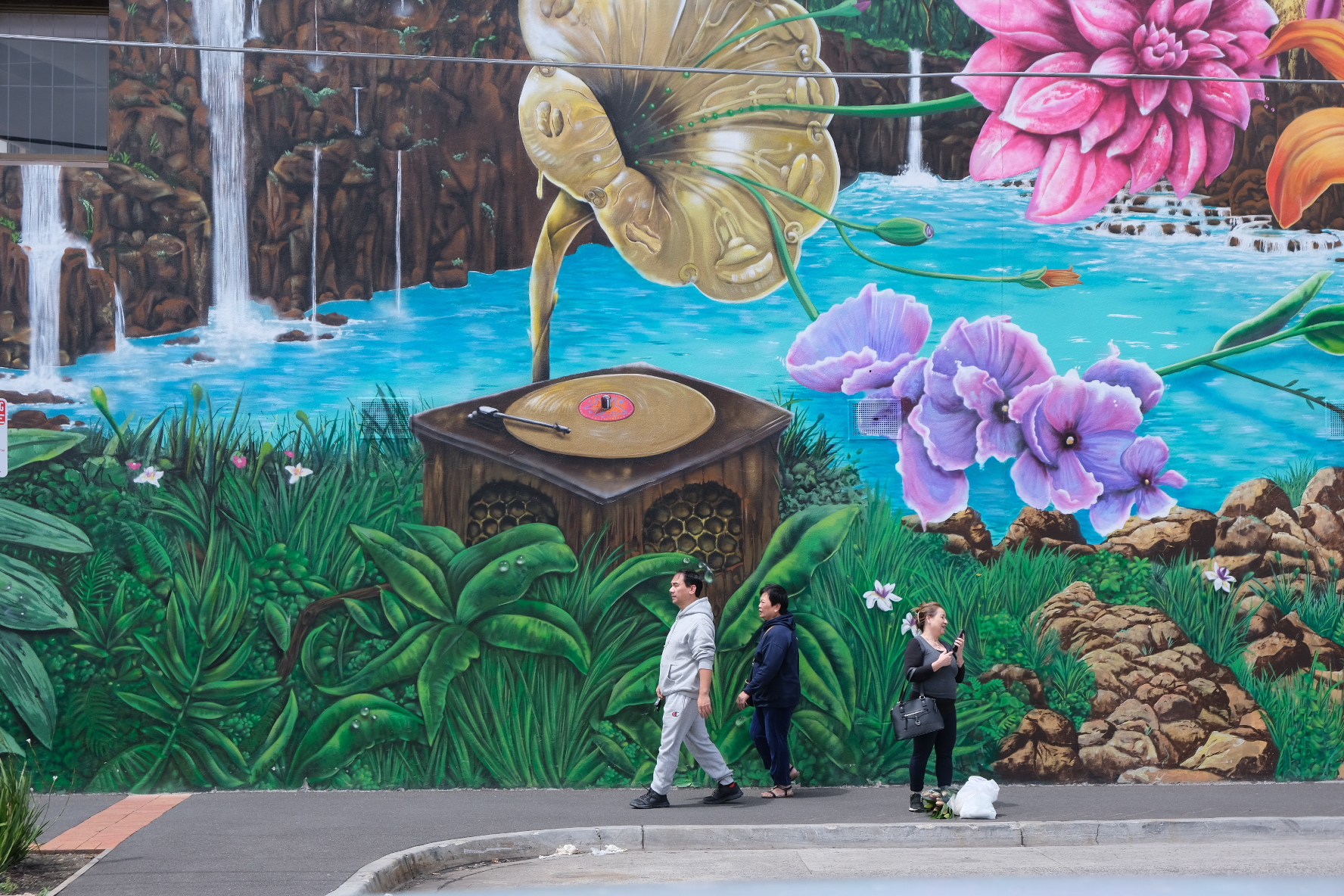Featured in

A HIP PINK and teal mural appeared outside the St Albans Woolworths in Melbourne’s outer north-west recently. In the image a young woman in a patterned headscarf and sneakers squats by a small child, perhaps her daughter, as they separate organic from recyclable waste. The text at the top reads Small acts make a Big Impact and loops around floating monstera leaves and blossoming waratahs.
This isn’t the first mural to go up in St Albans. In the past two years, there’s also been Flowers in A Minor, a montage of flowers and vintage record players on East Esplanade; a painting to commemorate the ANZACs on Furlong Road; and the jaunty Welcome to St Albans bubble writing on the side of the Telstra building.
Unlike the random assortment of scribbled tags, glossy stickers and hurried dick-and-ball drawings sprayed on fences and bins across the municipality by teens, these murals are there by design. And if you’re a low-income renter, you ought to be worried when you see them popping up in your neighbourhood. They might appear benign – cheery, even – but who exactly are these poppy, colourfully surrealist artworks designed to attract? And, perhaps more urgently, who are they designed to displace?
I’M NO NEUTRAL party: until recently, I worked for a local government arts department that commissioned muralists to create exactly these kinds of artworks in St Albans. I love to check out Melbourne’s thriving street art scene, and I’m exactly the kind of white collar (white) worker who might just be swayed into signing up for a lifetime of mortgage debt to purchase an apartment near a trendy mural – especially if there’s a wood-panelled coffee shop nearby. But we need to think critically about whether these murals are what existing communities want or need, particularly in disadvantaged areas when there’s been chronic underinvestment in affordable healthcare, roads and green open spaces.
St Albans is deeply multicultural, comprising mainly first- and second-generation immigrants from Vietnam, India and the Philippines, as well as a small but growing number of refugee families from the Horn of Africa. Around 70 per cent of the population speak a language other than English at home. Income and higher education levels are lower than the rest of Victoria. Most of the suburb is residential, full of single-storey red brick dwellings and the occasional cheaply built townhouse. Much of the suburb previously served as a dumping ground for Melbourne’s heavy industries, and many dwellings sit directly above toxic and radioactive waste. In the centre of the neighbourhood sits Alfrieda Street, a bustling area full of locals walking to and from its many pho restaurants and fresh-produce markets. It’s a place charmingly resistant to cultural homogenisation with its five-kilometre-per-hour crawling traffic and elderly street vendors touting home-grown herbs and vegetables, chillies and pot plants.
But recently the local council rezoned much of St Albans to abolish building size limits, allowing for significantly higher density redevelopment. This has given private developers carte blanche to buy up big and put high-rise apartment blocks and office towers where small suburban shops had once been.
And this is when the murals started appearing.
Local councils’ justifications for commissioning these murals have traditionally been to prevent graffiti, vandalism and other ‘anti-social behaviour’. This in and of itself is troubling. As Eda Gunaydin puts it in her essay about Parramatta in Second City, by harnessing art as a tool to control public behaviour, the arts become ‘part of the police-industrial complex, and all of us harmless cardigan-wearing bespectacled arts workers technically cops’.
Yet increasingly murals are rolled out by local government with the aim of rapid redevelopment and gentrification of traditionally working-class areas such as St Albans and Parramatta. Oli Mould, a British lecturer in human geography (and author of the brilliant polemical essay collection Against Creativity), describes this process as artwashing – ‘a process that uses artistic practices unwittingly (or not) in the service of private capital’. The broader function of officially sanctioned public art like this is to make a place more attractive to developers, other government agencies and middle-class home buyers.
But what does that mean for the people who already live there? All of this ‘regenerative economic activity’ might provide a windfall to local councils in search of more rate payers, and some of that money might even go to building new public amenities like pools, gyms and public parks. But that’s not going to mean much if you’re a new migrant juggling casual jobs to make ends meet and find yourself priced out of the area.
I DON’T BLAME the artists who paint these murals; it’s hard enough getting paid to be creative in this country. But I do think it’s worth examining how artists are being co-opted by local government to ‘re-energise’ typically working-class areas, especially when it results in people of colour with important local ties being displaced to further flung parts of town with even less public transport and healthcare.
As the Boyle Heights Alliance Against Artwashing and Displacement – a group of protesters from a predominantly Latinx area of Los Angeles – puts it, ‘What the community needs instead of galleries [is] authentic affordable housing for low-income people, emergency housing for homeless people and people displaced by gentrification, a laundromat, a needle exchange or harm reduction center, an affordable grocery store etc.’
In an ideal world, we’d have them all. But until then, I’d love to see the re-emergence of a street art movement in Australia that’s genuinely counter-cultural, weird, abrasive and urgent instead of this current crop of tame, government-funded murals that are either completely without meaning or peddling some trite social-justice message. Next time you see one of these go up in your neighbourhood, think about who it’s for and who it isn’t.

Share article
More from author

The tubs
GR OnlineWhat was in the tubs that was worth saving, anyway? The journals had already done their job by helping me process my emotions and, perhaps, become a better writer. Really, I could just chuck them out. But as I transferred them into the filing cabinet, my heart rate returning to normal, I began referring to my new storage system as ‘the Elkin Archive’.